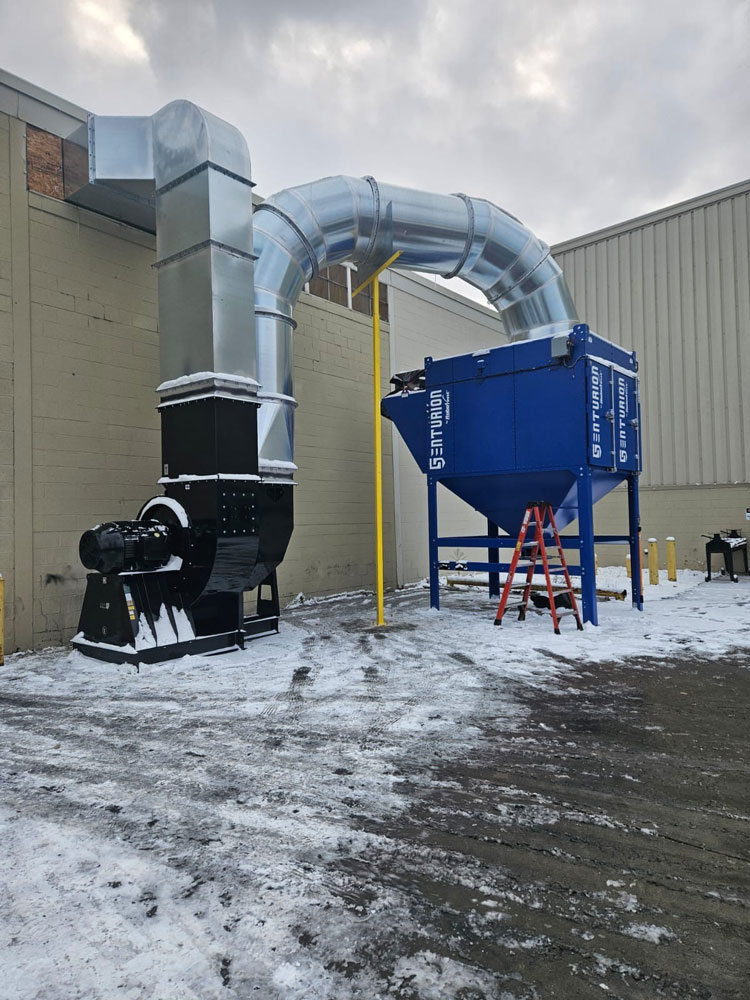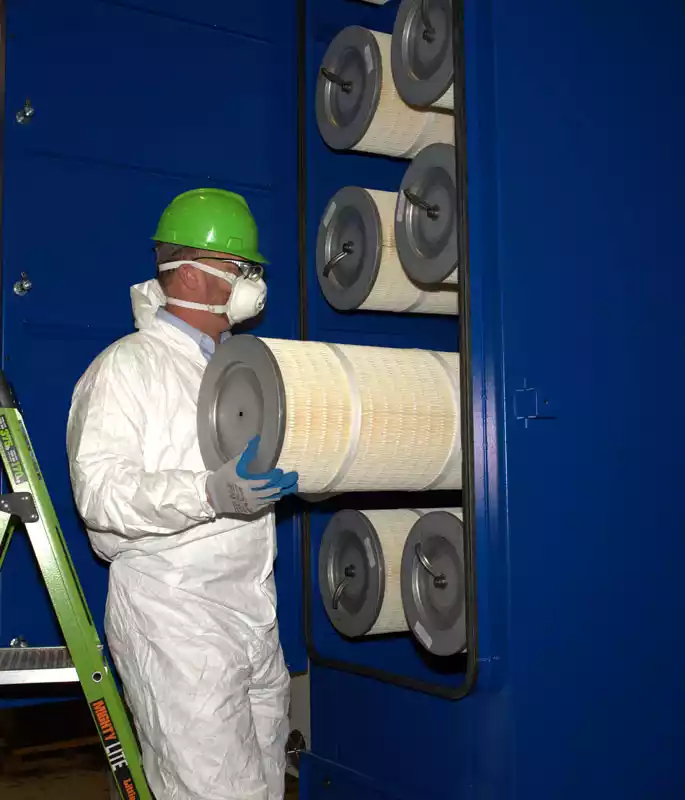Repair or Replace the Dust Collector? How to Make the Decision
 An industrial dust collector is a critical investment in facility safety and compliance. With proper care and maintenance, a properly designed dust collection system can last for up to 20 years. But when your system starts showing signs of wear, the big question arises: repair or replace? In this guide, we’ll help you make the right call, balancing cost, performance and future facility needs.
An industrial dust collector is a critical investment in facility safety and compliance. With proper care and maintenance, a properly designed dust collection system can last for up to 20 years. But when your system starts showing signs of wear, the big question arises: repair or replace? In this guide, we’ll help you make the right call, balancing cost, performance and future facility needs.
How Long Does a Dust Collector Last?
On average, a dust collector can last anywhere from 10 to 20 years, depending on several factors such as usage, maintenance practices, the type of dust being collected, and the environment it operates in. Systems that are well-maintained and regularly serviced can reach or even exceed the 20-year mark, while those exposed to harsh conditions or neglect may experience issues much earlier.
Key factors influencing dust collector lifespan include:
- Quality of equipment: Higher-end systems tend to last longer.
- Maintenance: Regular maintenance and timely replacement of parts (filters, seals, etc.) significantly extend a dust collector's life.
- Operating environment: Harsh conditions, such as high humidity, corrosive materials, or extreme temperatures, can shorten the lifespan.
Signs Your Dust Collector Needs Attention
As dust collectors age, their performance naturally declines. Key components like motors, fans, and seals begin to wear out, leading to reduced efficiency and performance. Over time, this leads to reduced airflow, higher energy consumption, and an increased risk of breakdowns and unplanned downtime. Older systems may also struggle to meet newer environmental regulations or handle growing production demands, making them less efficient and potentially more costly to maintain.
Here are some signs that the dust collector is nearing the end of its life—or at least due for an overhaul.
- Decreased Airflow or Dust Collection: If dust is escaping or accumulating in your facility, it’s a clear sign the system isn’t performing at full capacity. Clogged filters, leaks, or worn-out components could be the culprit.
- Increased Energy Costs: When your dust collector has to work harder to maintain the same performance, it will show up in your energy bills. A spike in operating costs might indicate that something’s wrong.
- Frequent Breakdowns: Constant repairs or downtime are a signal that your system is struggling. Recurring issues like motor failures, fan problems, or control malfunctions suggest that bigger problems may be looming.
- Noisy Operation: If your dust collector is noisier than usual, it might be a sign of mechanical wear, such as fan imbalance or motor issues.
- Age of the System: Even if your system seems fine, dust collectors over 10-15 years old might not meet current standards or handle increased production demands as efficiently as newer models.
Read more: Troubleshooting Common Dust Collector Problems
Repair or Replace? Making the Decision
When your cartridge dust collector starts showing signs of wear, it’s time to weigh your options. Here’s how to determine whether a repair will get the job done or if it’s time to invest in a replacement.
When to Consider Repair
If your dust collector is still relatively new and the issues are minor, a repair might be the most practical and cost-effective solution. Here’s when you should opt for repairs to keep your system running smoothly.
- Minor Issues: If the problem is isolated, like replacing a fan or fixing a seal, a repair might be the most cost-effective solution.
- Newer Equipment: If your system is less than 10 years old and hasn’t had many issues, repairing it could extend its life and save money.
- Cost-Effective Fix: If the repair costs are low and won't significantly disrupt operations, it's worth addressing the problem rather than replacing the entire system.
- Short-Term Needs: If you need a quick fix to keep operations running until you’re ready to invest in a new system, repairs can buy you some time.
When to Consider Replacement
Sometimes, ongoing repairs and outdated technology make replacement the smarter long-term investment. Here are the key signs it’s time to retire your current system and upgrade to a new one.
- Frequent Breakdowns: If you’re constantly calling for repairs, the cost of maintenance will eventually outweigh the benefits. Frequent downtime disrupts productivity, which makes replacement a better long-term investment.
- Aging Equipment: Dust collectors older than 15-20 years may struggle to meet current performance standards and regulations. Investing in a new system can improve efficiency and compliance.
- High Repair Costs: When repair costs exceed 50% of the price of a new unit, it’s usually more cost-effective to replace the system entirely.
- Increased Production or Efficiency Requirements: If your facility’s production has increased or your dust collection needs have changed, an older system might not be able to handle the extra demand efficiently. A new, more powerful system will likely save energy and improve performance.
- Regulatory Compliance: If your dust collector no longer meets NFPA standards or other safety regulations, a replacement may be necessary to avoid fines and ensure safety.
Long-Term Considerations in Making Repair or Replacement Decisions
When deciding whether to repair or replace your dust collector, it’s important to look beyond immediate costs and think about the long-term implications. By factoring in these considerations, you can make a decision that ensures your dust collection system remains reliable, efficient and compliant—whether that means investing in repairs or opting for a replacement. Here are some things to consider.
- Total Cost of Ownership: Repairs may seem less expensive upfront, but repeated fixes can add up over time. Compare the cumulative cost of maintaining an aging system with the price of a new, more efficient unit. A replacement may have a higher initial cost, but it could offer significant savings on energy, maintenance and repairs in the long run.
- Energy Efficiency: Older dust collectors often consume more energy than newer models. Upgrading to a more energy-efficient system can significantly reduce operational costs over time. This is particularly important if energy expenses are a significant part of your operating budget. Investing in a modern system with smart controls and a Variable Frequency Drive (VFD) motor can pay for itself in energy savings alone.
- Regulatory Compliance: Dust collection systems must comply with local, state and federal regulations, particularly when it comes to controlling emissions and combustible dust. If your system is outdated, it may no longer meet these standards, exposing your facility to fines or shutdowns. A new system can ensure compliance and protect your business from costly regulatory penalties.
- Production Demands: Consider the future needs of your facility. Will your dust collector be able to handle increased production or more stringent dust control requirements in the coming years? If your production is scaling up or your dust collection demands are changing, it might make more sense to replace an aging system with one that can meet your long-term operational goals.
- Technological Advancements: Modern dust collectors often come equipped with smart technology, such as smart control systems. These advancements allow you to optimize system efficiency, reduce downtime and avoid costly emergency repairs. Over time, the benefits of these features can justify the cost of replacing an older system.
Get More Life Out of Your Dust Collector
 The key to maximizing your dust collector’s lifespan is regular preventative maintenance and prompt attention to problems. Routine tasks like changing filters, inspecting seals and motors, and cleaning ductwork can prevent small issues from escalating into costly repairs. Addressing minor repairs as soon as they arise will help you avoid system breakdowns and keep everything running smoothly. Consistent care is the best way to extend the life of your dust collector and ensure it performs at its best.
The key to maximizing your dust collector’s lifespan is regular preventative maintenance and prompt attention to problems. Routine tasks like changing filters, inspecting seals and motors, and cleaning ductwork can prevent small issues from escalating into costly repairs. Addressing minor repairs as soon as they arise will help you avoid system breakdowns and keep everything running smoothly. Consistent care is the best way to extend the life of your dust collector and ensure it performs at its best.
Whether you need dust collector repair or preventative maintenance, RoboVent is here to help. Our factory-trained technicians can help you evaluate your dust collection system, get to the root of any issues, and keep your system in top operating condition. And when it’s time to consider replacement, our engineering team can design a dust collection system tailored for your application and optimized for efficiency and performance.
Contact us for service.
Contact Us With Your Questions!
SUBSCRIBE TO
BLOG UPDATES








